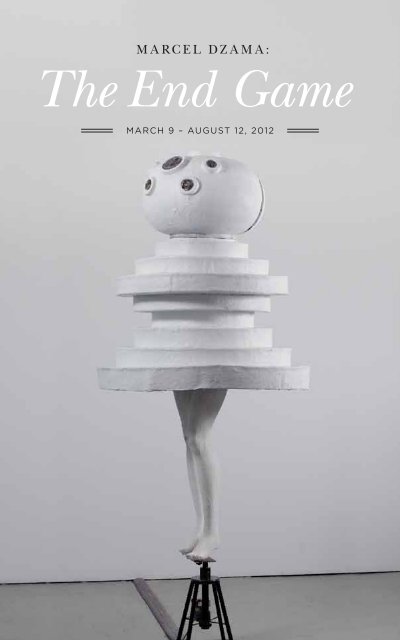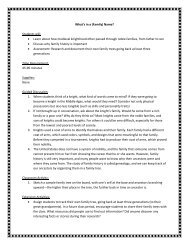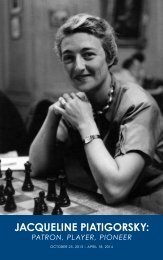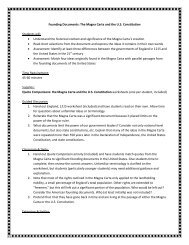The End Game
The End Game - World Chess Hall of Fame
The End Game - World Chess Hall of Fame
- No tags were found...
Create successful ePaper yourself
Turn your PDF publications into a flip-book with our unique Google optimized e-Paper software.
Marcel Dzama:<strong>The</strong> <strong>End</strong> <strong>Game</strong>March 9 – August 12, 20121
Marcel Dzama<strong>The</strong> <strong>End</strong> <strong>Game</strong>Marcel Dzama: <strong>The</strong> <strong>End</strong> <strong>Game</strong>features the artist’s film, A <strong>Game</strong> ofChess, alongside related drawings,sculptures, and dioramas.Dzama’s work draws from a diverse rangeof references and artistic influence, includingDada and Marcel Duchamp. His filmfeatures characters based on the classicgame of chess. Dressed in geometricallydesigned costumes of papier-mâché, plaster,and fiberglass and wearing elaborate masks(including a quadruple-faced mask for theKing), the figures dance across a checkeredboard to challenge their opponents infatal interchanges.Chess occupied a central role for the earlytwentieth-century avant-garde, who drewexplicit analogies between the game (withits intricate balance between improvisationand predetermination) and artistic practice.Dzama is influenced by German Bauhausartist Oskar Schlemmer, whose Triadic Balletfrom 1922 included puppet-like, costumed,and masked figures dancing across acheckered surface. French film-makerRené Clair and painter Francis Picabiawere amongst other artists who integratedballet and chess in their works from the1920s, employing the special set of rules andmoves of the game as metaphors for largerquestions regarding free will, destiny, andtechnological determinism.Both the filming and the creation ofthe costumes for A <strong>Game</strong> of Chess werecarried out in Guadalajara, Mexico, andthe influence of local crafts and religioustraditions can be felt throughout this bodyof work. Notions of scapegoatism andresurrection blend with the timeless ideaof rivalry represented by the game, anddistinctions between reality and fictionultimately become blurred as both costumedand “real-life” characters in the film arekilled. In this way, the storyline recalls theSurrealist predilection for dream logic overconventional narrative form—epitomizedby Luis Buñuel’s films from the late1920s and early 1930s. However, Dzamastill retains a strong sense of a plot, withsubtle insinuations to contemporary lifediscernible throughout.<strong>The</strong> exhibition also presents two rotatingsculptures based on central characters inthe film as well as new paintings createdespecially for this exhibition. Marcel Dzama:<strong>The</strong> <strong>End</strong> <strong>Game</strong> marks the first solo exhibitionof Dzama’s work in the Midwest.2Impressions of Braunschweig, 2011Ink, gouache, and graphite on paper20 pages, each: 11 x 8 ½"3
A <strong>Game</strong> of Chess, 2011Video projection, 14:02 minutesBlack and white, soundVideo dimensions varyDiorama: wood, cardboard,paper collage, acrylic, and ink8 x 6 x 3 7 / 8 "Edition of 445
Marcel DzamaArtist BioTop:A <strong>Game</strong> of Chess, 2010Graphite and watercolor on paper12 parts, each: 11 x 8 ½"Center:<strong>The</strong> Strategy of a PureSymbolic Order, 2011Collage, pencil, ink, andwatercolor on paper, 12 parts,each: 10 3 /4 x 8 1 /4"Bottom:<strong>The</strong> Queen’s Profile or Auxmille tours Revisité, 2010Graphite, watercolor,and ink on paper, 4 parts,each: 9 5 / 8 x 7 1 / 8 "Portrait of Marcel Dzama by Jason SchmidtBorn in 1974 in Winnipeg, Canada, MarcelDzama’s work is inhabited by an expansivecast of recurring human, animal, andhybrid characters. Typically manipulating adistinctive palette of muted browns, grays,greens, and reds, the artist has developed animmediately recognizable visual languagethat penetratingly explores human actionand motivation, often by means of theviolent, erotic, grotesque, and absurd. Hispractice unleashes a universe of childhoodfantasies and otherworldly fairytales,drawing equally from folk vernacular asfrom artistic influences that include Dadaand Marcel Duchamp. Widely known for hisworks on paper, Dzama has in recent yearsexpanded his practice to include sculpture,painting, film, large-scale polyptychs,and dioramas. In the latter, he constructsintricate, complex, three-dimensionalscenes using his signature drawings, collageelements, cardboard, and occasionallyceramics. He creates a cast of humanfigures, animals, and imaginary hybrids tolife, and has developed an internationalreputation and following for his art thatdepicts fanciful, anachronistic worlds.Dzama’s work has been the subject ofseveral solo exhibitions, most recently in2011 at Gemeentemuseum, <strong>The</strong> Hague,<strong>The</strong> Netherlands, and KunstvereinBraunschweig, Germany. In 2010, a majorsurvey was organized by the Musée d’artcontemporain de Montréal, Canada. Otherimportant solo exhibitions include thePinakothek der Moderne, Munich (2008);Ikon Gallery, Birmingham, England; Centrefor Contemporary Arts, Glasgow (both2006); and Le Magasin – Centre Nationald’Art Contemporain de Grenoble, France(2005). His work has been featured innumerous group exhibitions internationally,including the CCA Wattis Institute forContemporary Arts, San Francisco (2011and 2009); Art Gallery of Nova Scotia,Halifax, Canada (2009 and 2004); <strong>The</strong>Museum of Modern Art, New York (2009,2008, 2006, and 2005); P.S.1. ContemporaryArt Center, Long Island City, New York(2006); Whitney Museum of American Art,New York (2006); among others.Dzama’s work is in the collections of majormuseums and public institutions, includingthe Andy Warhol Foundation for the VisualArts, New York; Corcoran Gallery of Art,Washington, D.C.; Dallas Museum of Art;Musée d’art contemporain de Montréal,Canada; Museum of Contemporary Art, LosAngeles; <strong>The</strong> Museum of Modern Art, NewYork; Solomon R. Guggenheim Museum,New York; Tate Gallery, London; and theVancouver Art Gallery.Since 1998, his work has been represented byDavid Zwirner, New York. <strong>The</strong> artist lives andworks in New York.67
Marcel Dzama: <strong>The</strong> <strong>End</strong> <strong>Game</strong>March 9 – August 12, 2012Special thanks to Marcel Dzama and DavidZwirner, New York. Related programmingand a downloadable pdf of this brochurecan be found at www.worldchesshof.org.All written materials have been adapted bytext provided by David Zwirner, New York.World Chess Hall of FameDirector: Susan Barrett4652 Maryland AvenueSaint Louis, MO 63108(314) 367-WCHF (9243)Copyright World ChessHall of FameDesigned by TOKYBranding + DesignPrinted on Recycled PaperTwitter@WorldChessHOFFacebookWorld Chess Hall of FameFlickrwww.flickr.com/photos/worldchesshofCover Image:<strong>The</strong> Rook (La Torre), 2011Polyester resin, fiberglass,plaster, steel, and motor83 3 /4 x 39"Back Cover Image:<strong>The</strong> Queen (La Reina), 2011Polyester resin, fiberglass,plaster, steel, and motor104 ½ x 38"Images are courtesy the artistand David Zwirner, New York.8






